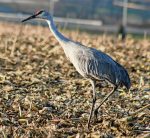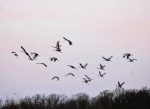On the otherwise silent morning as the sun began to peek over trees at Muscatatuck National Wildlife Refuge, a fluttering sound rose softly and slowly from a wetland, then grew gradually in intensity.
Stillness died as the sky brightened and flocks of sandhill cranes, 10, then 20, then another 25, rose, flapping wings, creating fresh formations. They responded as if an alarm clock sounded, prompting them to action. No sleeping in allowed.
It was a new day in their cycle, waking from water, flying to nearby farmland, where the birds could munch their fill before turning around at sunset and returning to a favored overnight refuge water perch.
The fall migration is a migratory bird highlight at Muscatatuck, in other places around Seymour, in nearby Brownstown and elsewhere in Indiana, a phenomenon and spectacle dazzling casual skywatchers, serious birdwatchers and wildlife photographers.
At Muscatatuck and in the Jackson County region, the winged visitors may amount to about 20,000 birds, refuge ranger Donna Stanley said. At sunrise and sunset, just look up and see how many you can see. That is what official counters do for the refuge.
“They spread out over a wide area,” Stanley said.
That means the birds don’t respect man-drawn boundaries, so a Muscatatuck crane might spend the night on water outside the refuge’s 7,800 acres. A Brownstown crane that prowls for food near the East Fork White River may move to a safer nightly perch.
The birds seek watery camping spots in darkness. The reason why they stand in water, Stanley said, is to use it as a buffer deterrent to predator. If a coyote or some such threatening beast were to approach making splashing noises, the crane could fly away in a hurry.
When the cranes depart each morning for dry land, they do not leave behind flight plans but wing it to a friendly looking open-land mass to devour ground-up husks and cobs left behind following harvests.
“Somehow, they figure it out,” Stanley said. “They find the best cornfield places.”
A group of cranes on a hillside against the backdrop of the morning sun in Seymour.
Lew Freedman | The Tribune
A sandhill crane prowls for food on a Seymour farm, hoping to eat its fill of corn.
Lew Freedman | The Tribune
A flock of the thousands of cranes that visit Muscatatuck National Wildlife Refuge at this time of year take off just after sunset in pursuit of a place to land and graze all day before returning to the refuge’s wetlands at sunset.
Lew Freedman | The Tribune
This group of sandhill cranes appears to have discovered a welcoming farm to spend a day chowing down with a healthy meal.
Lew Freedman | The Tribune
Sandhill cranes respond to sunrise almost as if hearing an alarm clock go off, taking off from their overnight perch to find a place to spend a day eating.
Lew Freedman | The Tribune
The flocks of sandhill cranes take off from their overnight perches almost in neat waves of 10 or 25 or some other random number — unless they are startled and all light off at once.
Lew Freedman | The Tribune
The largest gathering of cranes in Indiana, where they can generally easily be seen in the largest groups by humans, is at Jasper-Pulaski Wildlife Fish Wildlife Area in Medaryville, some two and a half hours north. More than 30,000 cranes congregate and may be seen from an organized viewing spot on the 8,062-acre state property.
The cranes begin arriving there in October from Minnesota, Michigan, Wisconsin and Canada and arrive more often in Jackson County in November and into December from the same northern areas.
Beginning with the first Tuesday in October, Jasper-Pulaski posts a crane count on its website and updates it weekly. On Oct. 4 of this year, the count was 744. On Nov. 8, it was 7,662. The count peaked this year on Nov. 28 at 32,938.
That wildlife area’s record is about 34,000 in one year, said property manager Nick Echterling. Jasper-Pulaski has a sophisticated boardwalk for crane viewing called the Sandhill Crane Observation Area, and there is no telling how many cranes might be seen together at sunrise and sunset.
“Year after year,” Echterling said.
A study of cranes in Brownstown indicates the sandhills began stopping at the Ewing Bottoms in about 1990. They spread out for farmland food in Seymour and west to Medora, sometimes also crossing county lines into Bartholomew and Jennings counties.
Before that era began, the birds flew farther south for wintering, Stanley said, to Georgia and Florida. But the flocks expanded and needed more space. The cranes discovered they could stay in Indiana and not freeze — most of the time. If winter gets extremely cold and stays cold, the birds may not stay until March when they otherwise might begin migrating north again.
“They found out they can hang out around Jackson County,” Stanley said.
Very rare whooping cranes sometimes mix together with sandhill cranes, but Stanley said there have been none reported being spotted thus far this year.
While it seems impossible to be able to count bird by single bird if cranes flew in a bunch of thousands, the human counters benefit from the crane behavior of flying in more bite-sized flocks. Beginning in October and continuing into December, Jasper-Pulaski deploys counters in groups of five to determine its weekly counts.
“It’s a lot easier to count flocks,” Echterling said. “You get flocks of hundreds.”
The cranes return nightly in autumn and pick out shallow water places at Jasper-Pulaski. But they are more likely to leave for Georgia and Florida than Jackson County birds.
“Once the property freezes,” Echterling said.
Making the cranes literally snowbirds, mimicking the slang applied to winter tourist visitors from the north.
Just who are these birds that stir up such a flap?
Sandhills are gray with an average weight of 10 pounds for males and slightly less for females. Their height is basically 2½ to 4½ feet.
The birds have red foreheads, white cheeks and distinctive pointy bills. When flying, they resemble sleekly designed jet airplanes. Their very long legs trail behind, and since they are pointing necks upwards, it can be said they fly nose up, just as a plane does at take-off. Similarly, when cranes spread their wings, it is a notable sight, wingspans measuring from 5½ to 7½ feet.
Sandhill cranes were first identified as a species in 1750. However, sandhill fossils have been found in Nebraska (sight of the original sandhills) that are 10 million years old.
When gathered in large flocks, cranes can make a lot of noise. Enough of them trumpeting together could imitate a big-city traffic cacophony of car horns.
State ornithologist Allisyn-Marie Gillet said she did sandhill counts at Jasper-Pulaski in 2016, encountering what she called groups of thousands.
“It is loud,” she said. “That volume engages all the senses. It’s fun and amazing.”
She said it is easier to count flocks spread out in the sky.
Gillet fields calls at her office from people who have only heard that there are cranes out and about in large numbers in Indiana.
“Most people want to know where to find them,” she said.
The reason why there can be a permanent structure of a viewing platform at Jasper-Pulaski is because the cranes always come back through that area of northern Indiana. Data go back to 1967, and in 1976, the pass-through total was around 12,000 on its way to the 30,000-plus mark. The crane grapevine at work?
“It’s a traditional stopover,” Gillet said. “Cranes are creatures of habit. It has grown pretty significantly.”
Drying up of a favored wetland, as has occurred, means the cranes seek a substitute water area. Stanley said there has been such drying of land around Brownstown.
Most of the cold-weather arrivals will go farther south if the Jasper-Pulaski wetland freezes, Echterling said. But not all. There is a power plant with warm-water discharge in Wheatland, he said, and some cranes go there.
“A lot of them will stay here,” Gillet said. “They feel that’s their spot. Some go to Alabama. They will pick and choose depending on the water. If it freezes over, they might want to move on to open water.”
The on-again, off-again daily crane cycle of switching between agricultural field for food and safe place to spend the night is readily understood. However, one behavioral aspect that entrances viewers is the sandhill cranes’ propensity for communicating through dance.
“They practice dancing with each other,” Gillet said, as a warmup for a mating ritual.
Some of it is apparently flirting, though in the case of younger birds, some of it is probably play.
The dancing is a visual delight, Stanley said.
“They dance with their mates,” she said. “They dance with their offspring.”
It’s “Saturday Night Fever” all the time.
There was no abrupt signal launching one gigantic flock of thousands of sandhill cranes into the air out of Muscatatuck on the clear sunny morning. In contrast, smaller groups took off in squadrons, as if getting their clearance one after another from the flight tower.
Who knew what the leader of the pack trumpeted to the others before stretching his neck forward and flapping wings? But it was good enough for the followers to head out for an all-day buffet on Seymour farmland.






